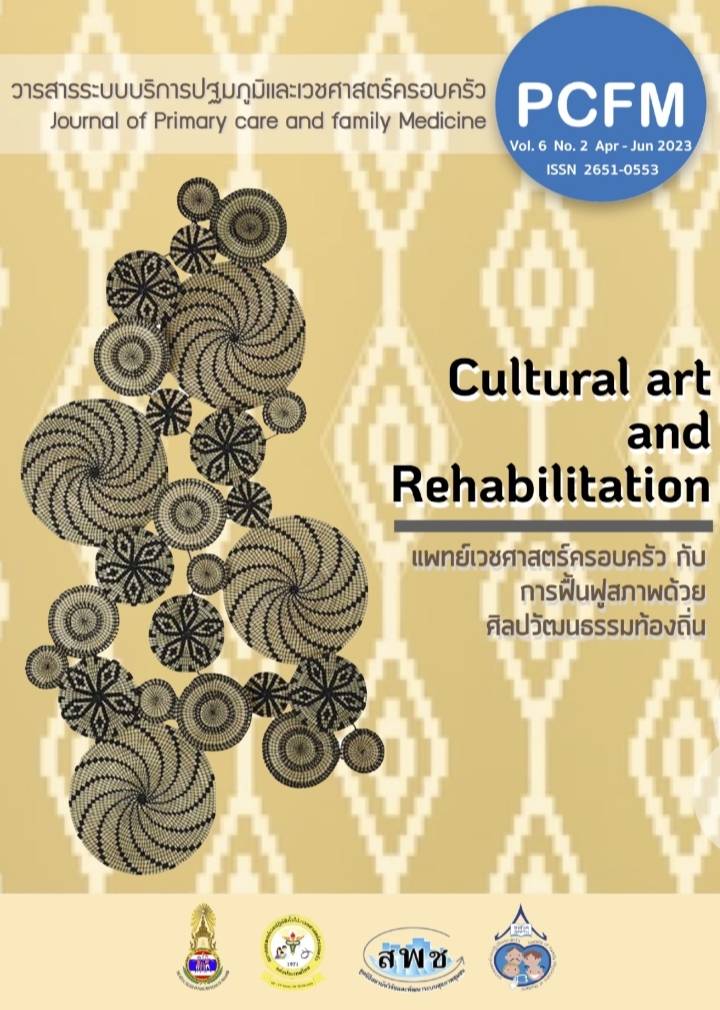การดูแลรักษาการติดเชื้อทางเดินหายใจส่วนต้นชนิดเฉียบพลัน: บทบาทของการรักษาในระยะเริ่มต้น
Main Article Content
บทคัดย่อ
การติดเชื้อทางเดินหายใจส่วนต้นชนิดเฉียบพลันมีสาเหตุมาจากการติดเชื้อไวรัสหรือแบคทีเรียที่บริเวณโพรงจมูก โพรงไซนัส คอหอย และกล่องเสียง ส่วนใหญ่การติดเชื้อดังกล่าวมักเป็นระยะสั้น มีอาการไม่รุนแรง และหายได้เอง แต่บางกรณีอาจนำไปสู่โรคแทรกซ้อนที่รุนแรง ส่งผลให้เกิดปัญหาทางสังคมและเศรษฐกิจ ทั้งต่อตัวบุคคลและสังคมโดยรวม การรักษาส่วนใหญ่ คือ การใช้ยารักษาตามอาการ ตัวอย่างเช่น ยาหดหลอดเลือดและยาทาระเหยเพื่อบรรเทาอาการคัดจมูก ยาต้านฮิสทามีนหรือยาแก้แพ้ ยาลดไข้ เช่น พาราเซตามอล ยาต้านการอักเสบที่ไม่ใช่สเตียรอยด์ ชนิดรับประทาน ยาขับเสมหะ ยาละลายเสมหะ ยาแก้ไอ เป็นต้น ซึ่งวิธีการรักษาในระยะเริ่มต้นเพื่อป้องกันการลุกลามของอาการมีอยู่จำกัด ตัวอย่างเช่น การใช้ neuraminidase inhibitors เพื่อป้องกันไวรัสแพร่ออกจากโฮสต์เซลล์ ปัจจุบันมีนวัตกรรมโพลิเมอร์ชนิดพ่นจมูกซึ่งมีผลการศึกษาทางคลินิกแสดงให้เห็นว่ามีประสิทธิภาพเมื่อใช้ในการรักษาในระยะเริ่มต้นของการติดเชื้อทางเดินหายใจส่วนต้นชนิดเฉียบพลันก่อนที่จะมีอาการชัดเจน โดยออกฤทธิ์จับกับอนุภาคไวรัสได้หลายชนิด ป้องกันไม่ให้ไวรัสเข้าสู่เนื้อเยื่อ ซึ่งลดความรุนแรงของโรคและโอกาสติดเชื้อได้ ดังนั้นการใช้นวัตกรรมโพลิเมอร์ชนิดพ่นจมูกในการลดความรุนแรงและระยะเวลาการเป็นโรคจะเป็นประโยชน์เพิ่มเติมจากการรักษาในปัจจุบัน
Article Details

อนุญาตภายใต้เงื่อนไข Creative Commons Attribution-NonCommercial-NoDerivatives 4.0 International License.
เนื้อหาและข้อมูลในบทความที่ลงตีพิมพ์ในวารสาร PCFM ถือเป็นข้อคิดเห็นและความรับผิดชอบของผู้เขียนบทความโดยตรง ซึ่งกองบรรณาธิการวารสารไม่จำเป็นต้องเห็นด้วยหรือร่วมรับผิดชอบใด ๆ
บทความ ข้อมูล เนื้อหา รูปภาพ ฯลฯ ที่ได้รับการตีพิมพ์ลงในวารสาร PCFM ถือเป็นลิขสิทธิ์ของวารสาร PCFM หากบุคคลหรือหน่วยงานใดต้องการนำทั้งหมดหรือส่วนหนึ่งส่วนใดไปเผยแพร่ต่อหรือเพื่อกระทำการใด ๆ จะต้องได้รับอนุญาตเป็นลายลักษณ์อักษรจากวารสาร PCFM ก่อนเท่านั้น
เอกสารอ้างอิง
Wang DY, Eccles R, Bell J et al. Management of acute upper respiratory tract infection: the role of early intervention. Expert Rev Respir Med. 2021 Dec; 15(12): 1517 – 1523.
Heikkinen T, Järvinen A. The common cold. Lancet. 2003 Jan; 361 (9351): 51 –59.
Grief SN. Upper Respiratory Infections. Prim Care. 2013 Sep; 40(3): 757 – 770.
Turner RB. The common cold. Goldman’s Cecil Med. 2012: 2089 – 91.
Winther B, Gwaltney JM Jr, Mygind N, et al. Viral Induced Rhinitis. Am J Rhinol. 1998 Jan;12(1): 17 – 20.
Linder JA, Singer DE. Health-related quality of life of adults with upper respiratory tract infections. J Gen Intern Med. 2003 Oct; 18(10): 802 – 807.
Thomas M, Bomar PA. Upper respiratory tract infection. StatPearls. Treasure Island (FL): StatPearls Publishing LLC; 2022 Jan.
Meneghetti A. Upper respiratory tract infection [Internet]. Medscape; 2020 [cited 2022 March 3]. Available from: https://emedicine.medscape.com/article/302460-overview.
Cough and cold remedies for the treatment of acute respiratory infections in young children 2001 [Internet]. World Health Organization [cited 2022 March 3]. Available from: https://apps.who.int/iris/handle/10665/66856.
Pratter MR. Cough and the common cold: ACCP evidence-based clinical practice guidelines. Chest. 2006 Jan; 129 (1Suppl): 72S – 74S.
Virgincar N, Spencer R. Current management options for upper respiratory tract infection. Prescriber. 2006 Jan; 17(1): 16 –23.
Eccles R. Understanding the symptoms of the common cold and influenza. Lancet Infect Dis. 2005 Nov; 5(11): 718 – 725.
Witek TJ, Ramsey DL, Carr AN, et al. The natural history of community- acquired common colds symptoms assessed over 4-years. Rhinology. 2015 Mar; 53(1): 81 – 88.
Papadopoulos NG, Megremis S, Kitsioulis NA, et al. Promising approaches for the treatment and prevention of viral respiratory illnesses. J Allergy Clin Immunol. 2017 Jul; 140(4): 921 –932.
Rollinger JM, Schmidtke M. The human rhinovirus: human-pathological impact, mechanisms of antirhinoviral agents, and strategies for their discovery. Med Res Rev. 2011 Jan; 31(1): 42 – 92.
Hsu J, Santesso N, Mustafa R, et al. Antivirals for treatment of influenza: a systematic review and meta-analysis of observational studies. Ann Intern Med. 2012 Feb; 156(7): 512 – 524.
Moraga-Espinoza D, Warnken Z, Moore A, et al. A modified USP induction port to characterize nasal spray plume geometry and predict turbinate deposition under flow. Int J Pharm. 2018 Sep; 548 (1): 305 – 313.
Shin Y, Kokate R, Desai V, et al. D-cycloserine nasal formulation development for anxiety disorders by using polymeric gels. Drug Discov Ther. 2018; 12(3): 142 – 153.
Pandey P, Cabot PJ, Wallwork B, et al. Formulation, functional evaluation and ex vivo performance of thermoresponsive soluble gels - A platform for therapeutic delivery to mucosal sinus tissue. Eur J Pharm Sci. 2017 Jan; 96: 499 – 507.
Braga PC, Alfieri M, Dal Sasso M, et al. Visual evaluation of binding to mucosal cells of a medical device against the common cold. Drug Dev Ind Pharm. 2008 May; 34(5): 459 – 64.
Cook SL, Bull SP, Methven L, et al. Mucoadhesion: a food perspective. Food Hydrocoll. 2017 Nov; 72: 281 – 296.
Leibbrandt A, Meier C, König-Schuster M, et al. Iota-carrageenan is a potent inhibitor of influenza A virus infection. PLoS One. 2010 Dec; 5 (12): e14320.
Grassauer A, Weinmuellner R, Meier C, et al. Iota-Carrageenan is a potent inhibitor of rhinovirus infection. Virol J. 2008 Sep; 5: 107.
Hull D, Rennie P, Noronha A et al. Effects of creating a non-specific, virus-hostile environment in the nasopharynx on symptoms and duration of common cold. Acta Otorhinolaryngol Ital. 2007 Apr; 27(2): 73 – 7.
Eccles R, Meier C, Jawad M, et al. Efficacy and safety of an antiviral Iota- Carrageenan nasal spray: a randomized, double-blind, placebo-controlled exploratory study in volunteers with early symptoms of the common cold. Respir Res. 2010 Aug; 11(1): 108.
Marieb EN, Hoehn K. eds. Human Anatomy & Physiology. 7th ed. San Francisco, CA: Pearson Education, Inc.; 2007: 788 – 826.
แนวทางเวชปฏิบัติ การวินิจฉัย ดูแลรักษา และป้องกันการติดเชื้อในโรงพยาบาล กรณีโรคติดเชื้อไวรัสโคโรนา 2019 (COVID-19) สำหรับแพทย์และบุคลากรสาธารณสุข ฉบับปรับปรุง วันที่ 22 มีนาคม 2565 [Internet]. กรมการแพทย์ [updated 2022 March 22; cited 2022 April 4]. Available from: https://covid19.dms.go.th/backend/Content/Content_File/Covid_Health/Attach/25650324144250PM_CPG%2022%E0%B8%A1%E0%B8%B5%E0%B8%99%E0%B8%B2.pdf.
DeGeorge KC, Ring DJ, Dalrymple SN. Treatment of the Common Cold. Am Fam Physician. 2019 Sep;100 (5): 281 – 289.
Sharma R, Agarwal M, Gupta M, et al. Clinical characteristics and differential clinical diagnosis of novel Coronavirus disease 2019 (COVID-19). In: Saxena SK eds. Coronavirus disease 2019 (COVID-19). Medical Virology: From Pathogenesis to Disease Control. Springer, Singapore; 2020. p. 55 – 70.
Qureishi A, Lee Y, Belfield K, et al. Update on otitis media - prevention and treatment. Infect Drug Resist. 2014 Jan; 7: 15 – 24.
Anderson J, Paterek E. Tonsillitis. [Updated 2021 Aug 11]. In: StatPearls [Internet]. Treasure Island (FL): StatPearls Publishing; 2022 Jan.
ChanvatikI S, Kosiyaporn H, Lekagul A et al. Knowledge and use of antibiotics in Thailand: A 2017 national household survey. Plos One. 2019 Aug; 14(8): e0220990. https://doi.org/10.1371/journal.pone.0220990.
ซูโดอีเฟดรีน (pseudoephedrine) [Internet] กองควบคุมวัตถุเสพติด สำนักงานคณะกรรมการอาหารและยา
[updated 2020 October; cited 2022 March 3]. Available from: https://www.fda.moph.go.th/sites/Narcotics/SitePages/ViewAcademic.aspx?IDitem=5
Graf P, Enerdal J, Hallén H. Ten days' use of oxymetazoline nasal spray with or without benzalkonium chloride in patients with vasomotor rhinitis. Arch Otolaryngol Head Neck Surg. 1999 Oct; 125(10): 1128 – 32.
Bautista DM, Siemens J, Glazer JM, et al. The menthol receptor TRPM8 is the principal detector of environmental cold. Nature. 2007 Jul; 448 (7150): 204 – 8.
ประกาศสํานักงานคณะกรรมการอาหารและยา เรื่อง หลักเกณฑ์ วิธีการ และเงื่อนไข ในการขายยา. [updated 2015 August 4; cited 2022 March 3]. Available from: https://papc.pharmacycouncil.org/share/file/file_1721.เงื่อนไขการขายยา.PDF


